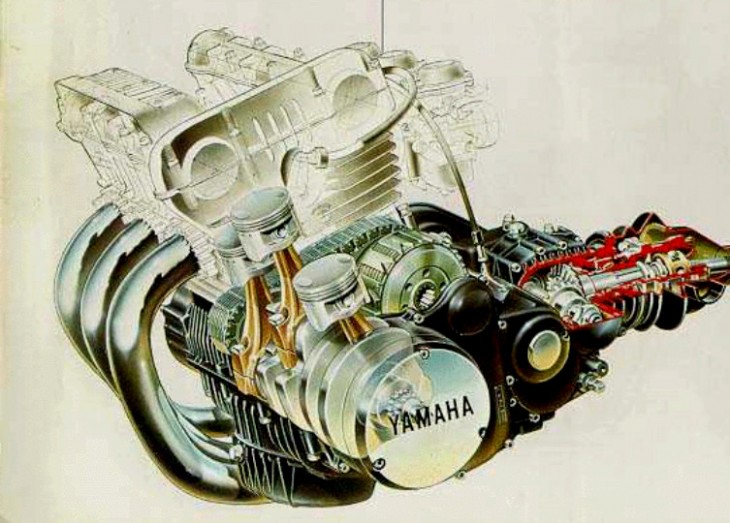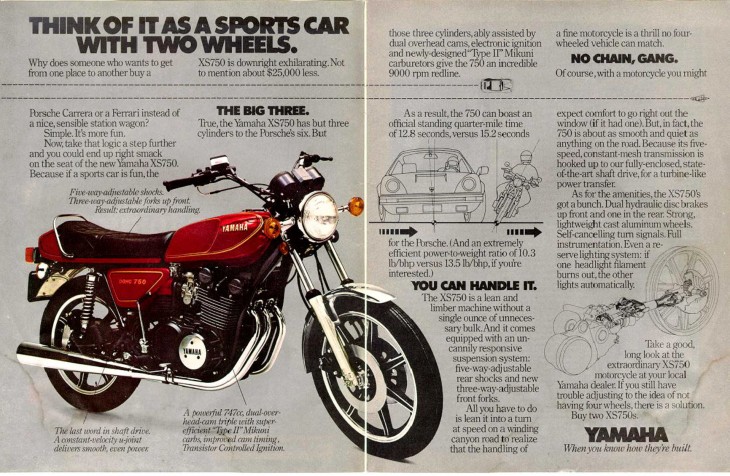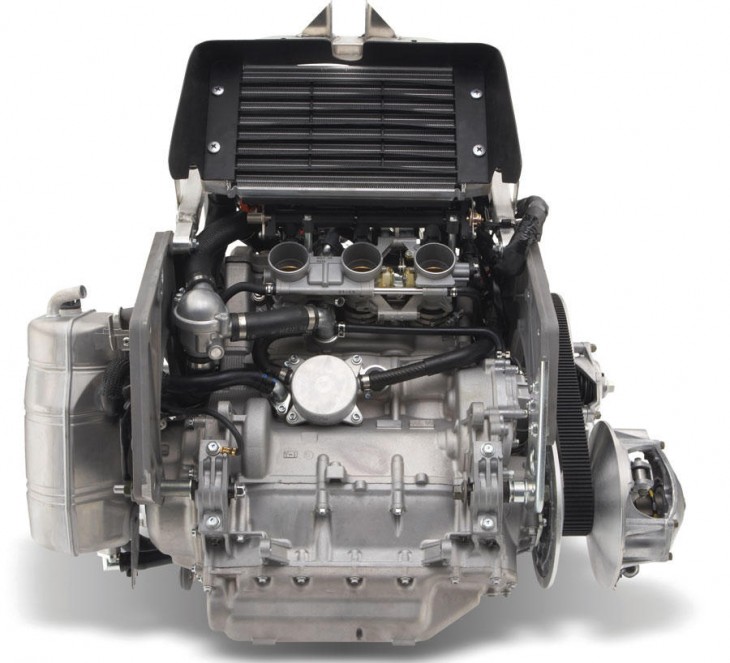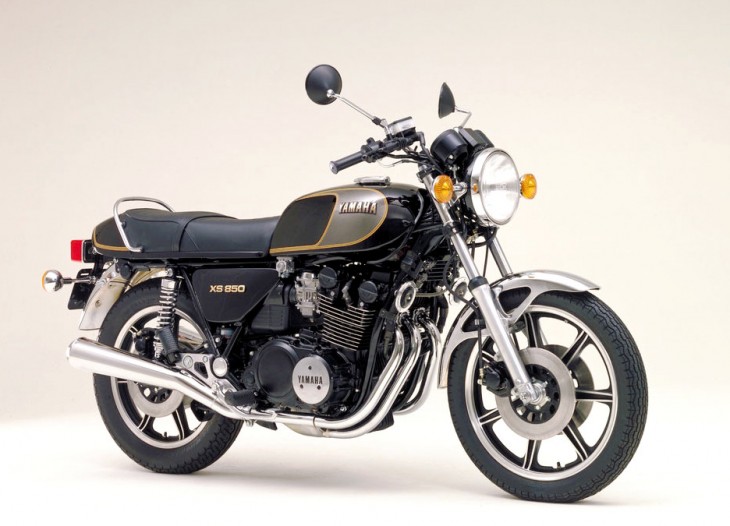I like the sound and feel of three-cylinder engines. When the Hinckley Triumphs arrived in the U.S. market in the 1990s, I decided to buy a Trophy, which was available as a 900cc triple or a 1200cc four. I rode both, and quickly decided the triple was the one I wanted. Although the 1200 was faster, the 900 just felt more alive, somehow. I fell in love with that motor.
Triumph, of course, is known for its three-cylinder engines. After Hinckley tried to slug it out with the Japanese in the 600cc, four-cylinder supersport category, Triumph wised up and created the wonderful 675cc triple we know today. MV Agusta has recently joined the fray with its own 675cc triple.
Yamaha appears to be next in line. As we reported, Yamaha used INTERMOT to display a three-cylinder concept, and confirmed that at least one three-cylinder model will see production in the near future. As we pointed out in the same article, Yamaha has manufactured three-cylinder motorcycles in the past, including the XS750 and XS850 produced between 1976 and 1981. These bikes gained a good reputation for comfort and engine smoothness, and are still coveted by enthusiasts today. I found this web site dedicated to all things “Yamaha triple” that you may want to take a look at (it contains many interesting links and PDF files).
The XS750 and XS850 were never intended to be the highest performing street bikes of their era, but that doesn’t mean Yamaha hasn’t produced high performing triples.
I am not a snowmobile enthusiast (I grew up in California), but I am aware that Yamaha builds some extremely powerful snowmobiles used for both recreation and racing. One of those is the FX Nytro RTX, which features a modern, liquid cooled, fuel injected 1049cc, four-stroke triple that puts out in the neighborhood of 130 hp.
So, Yamaha certainly knows how to engineer, and manufacture, in-line three-cylinder engines and, at least in snowmobiles, currently has a large displacement triple in production. The INTERMOT announcement should therefore be no major surprise.
The question is what type of three-cylinder motorcycles will Yamaha produce, and when? There is already a rumor that the current R1 superbike and R6 supersport will be succeeded by three-cylinder models approximately in the 2014 model year. I personally wouldn’t be surprised if Yamaha put three-cylinder engines in other types of motorcycles, not just sport bikes. The 1978 XS750 Special (pictured) leaned toward the custom or chopper genre, for instance.
There is an additional rumor that Yamaha is trying to obtain guidelines for three-cylinder engine displacement limits for WSB. Currently, four-cylinder bikes are limited to 1000cc and twins are limited to 1200cc. Physics suggests triples should be allowed a special displacement somewhere between the two. Of course, there is already precedent for allowing 675cc triples in supersport racing.
Frankly, we are surprised no other Japanese manufacturer has used the three-cylinder engine as a product differentiator in recent times. Designed correctly, the engines offer great character and performance, with a nice compromise between the low-end grunt of a twin and the shrieking top-end of a four. It will certainly be interesting to watch Yamaha go down this path, once again.











I love shafties, the low maintenance is ideal for where i live. dont get me wrong i know chain drives offer more power but for something that will be used as a daily commuter, i would love it if yamaha brings back shaft drive tripples.
The late ’70s were very interesting times for Yamaha. You could get an SR500 single, XS650 twin, XS750/850 triple and XS Eleven four. Only Honda, with singles, parallel twins, v-twins, inline fours, flat fours and inline sixes had a range as diverse, and they still didn’t have a triple.
I own an XS Eleven which shares much of the engine’s architecture with the XS750/850 triples. It’s a great motorcycle.
The 1980 Yamaha XS850 looks so cool. If only they are still available today. We have 2 honda motorcycles. Just the moped ones. I have always wanted to drive the bigger motorcycles.
I saw a Yamaha snowmobile with a 900 cc triple motor a couple of years ago. What a sweet sounding motor.
I remember thinking what great motor for a bike. I love the way a Vtwin makes power and the excitement of an Inline four. To me a triple gives the best of both. I owned a 1981 Yamaha Seca 750 and felt it was a bike that was ahead of it’s time.
I also recall a 900 Seca. Both I think were shaft drive. I hope Yamaha brings a 1090 Seca. That would be sweet!
I’ve had a lot of bikes over the years but my 1978 XS750 (just like the red one in the ad above) was one of if not the best. A bike that for the times did everything quite well, not a standout but damn competent. Loved the sound of the triple and its was smooth too.
I sure hope Yamaha dose this but please put it in the FZ1 a 3 cyl engine would be great..I have never understood why Yamaha never put the cross plane engine in the FZ1.
As the owner of 2012 Street Triple R… all I can say is wow… the rush of an inline and the smoothness as well, but the torque more than enough. Thought my breathed on SV650 was torquey, but not a contest. Now take that and do a crossplane or some other firing order and let’s see what happens. I am in line for sure… if I tire of my T… I won’t. 🙂
I am guessing that removing a cylinder with all it’s valve train parts takes a good bit of cost out of the product. Good move on Yamaha’s part from a profitability perspective.
Then I bought a Kawasaki Mach 1, a 3 cylinder 2 stroke and wow, let the games begain.
re: “There is already a rumor that the current R1 superbike and R6 supersport will be succeeded by three-cylinder models approximately in the 2014 model year.”
that’s only what we call the dumbest rumor ever.
And that’s what we call the dumbest comment ever.
Yamaha showed a “crossplane” three-cylinder engine at the INTERMOT show this year. Visordown got word from their sources within Yamaha Japan that the Yamaha YZF-R6 & Yamaha YZF-R1 will be two of the bikes to receive such engines. Since Triumph and MV Agusta both produce performance bikes with triples, it hardly seems like such a stretch to believe that Yamaha could — or would.
re: “Since Triumph and MV Agusta both produce performance bikes with triples”
you forget… benelli and petronas ALSO produced performance bikes with triples. bikes that were ner-do-well and got handed their ass in the large displacement category.
re: “it hardly seems like such a stretch to believe that Yamaha could — or would.”
only to the layperson ignorant to history. yamaha just invested 7 years in the greatest R&D excercise in the history of grandprix and motorcycling (furasawa, rossi, WSBK, spies, etc) to commercialize a 4-cylinder crossplane. they (yamaha) have given birth to an entirely new engine configuration and they OWN it. when’s the last time this has happened in any sector car or motorcycle…? this is the equal if not the greater of what honda did in ’69 with the CB750. nothing chapped honda’s ass more than the release of the ’09 R1.
for those keeping score at home (or perhaps NOT keeping score i should say), so far yamaha has won 9 titles with this technology, and hayes and lorenzo just added 2 more titles bringing the total to a whopping 12…! the tuning fork didn’t achieve all this by being too stupid to know that “you don’t fix anything that isn’t broken”. they have a USP and will not give that up by randomly lopping of a cylinder.
that untested engine you see is not destined for any of their class winning sportbikes. bad business decisions regarding one’s USP is the domain of dorna/ezpelata, not a manufacturer who just revolutionized the industry and has yet to see a ROI given that the tech’s only offered in a single model.
Blah blah, they pretty much announced it already. Although they talked about a crossplane triple which is not really known at this point.
Bottom line is the current engine is not making people run out and buy lots of R1s. I don’t know if it’s the crossplane but Kawi and BMW are putting out much more power.
Regardless of the race bikes, triples make a lot of sense on the street, with extra torque and reduced cost. Especially for the smaller displacement models. Yamaha has wised up and knows that it’s foolish to be a slave to the past. Innovate or die.
re: “After Hinckley tried to slug it out with the Japanese in the 600cc, four-cylinder supersport category, Triumph wised up and created the wonderful 675cc triple we know today.”
yeah they did…!
I have always thought the design language Yamaha used for the XS850 above, and especially the 1978 XS Eleven Standard resulted in some fine looking bikes and I would love to see a modern bike manufactured in that style.
Yep , I owned a XS 850 Special and loved it, I now own a FJR 1300.
would I think of purchasing a new Tripple from yamaha ? Yes in a heart beat ….
That’s “Trippple” from Yamaha!
I love my BMW triple; awesome, smooth engine with a nice shaft drive (keeping the splines greased). Next in line is my old ’82 Yamaha XJ650 Seca; beautiful 70+ horse I4 and a shaft drive. My 900 Monster is popular with all my friends but, meh, not nearly as smooth and sophisticated as the two previously mentioned bikes.
I would definitely be interested in a Yamaha triple. Make mine a 650 with shaft drive and a center stand and the other a peaky 600 naked chain driven sport bike… WOO YEAH!
-todd
Doesn’t everyone remember Aprilias Cube, for motoGP? I thought that was perfect. Smaller package than an inline four, less overall weight, and arguably same power. Didn’t hurt it borrowed 3 F1 cylinders.
Second case in point. Take a 186HP S1000RR and lop off a cylinder. 140HP 750cc…10-15 more than a current gen GSX-R750, that would likely be narrower, lighter, less crank inertia, less gyroscopic impact = handle better. I have never owned a Yamaha, but I would trade my GSX-R in for that!
Ask Colin Edwards how much he remembers the Cube. Particularly when it grenaded into flames underneath him at near 200mph. I’ve never heard anyone else call a motorcycle “born evil”.
Still, for the street, high performance triples probably make more sense than a high performance 4.
Fixed a whole lot of transmissions in those things, of course fixed a bunch of transmissions in the XS11 also. If you rode the 750 to hard the center con rod would fail, seems the cases flexed and that center journal would lose oil. 850’s were much improved.
I had a 750 triple-great bike- good low end and smooth cruising. Only sold it because somebody made me an insane offer for it.
I bought a 1980 Yamaha XS850 Special (cruiser type) about three years ago (2009) for $1000. It had been well kept up and refreshed somewhat. Rode it about two years and then sold it due to financial needs related to todays flat economy. I’ve been riding since 1967 and had a number of bikes, but never a triple before. Above all I loved it for the the sound of the triple winding out to full song, definitely not a twin and not a four either. Had some electrical issues with it but nothing that I couldn’t solve with the help of the internet. It wasn’t super fast, nor super smooth…I never really got comfortable with the rubber mounted handlebars. But it was fun to ride and definitely not a cookie cutter type of bike. Almost everywhere I went other bikers would do a double take and then “Is that a three cylinder!?” I’ve spotted another one for sale locally on craiglist and am trying to keep from going to look at it….
My first street bike was a 77 yam triple and I rode it from Canada to Mexico only needing to fill the tank and take some emery cloth to the points from time to time. Smooth, comfortable and reliable. Loved that bike and wished to heck I didn’t crash it. That crash left me a missing finger to remind me of the good old times…
Hell for leather site claims it will have outer pistons rise and fall together. Centre piston at 90 degrees with a slave piston for vibration.
There seems to be a trend toward fewer cylinders (cars and trucks also) maybe due to emissions requirements.
Also on the xs they managed to make the countershaft bevel very compact. Seems like the newer vtwin shafties have a huge chrome wart on the countershaft.
I think those swingarm pivots were kinda underbuilt in the day. I owned a shaft-drive Kawi cruiser for a year or two. Just a steel dowel poked through an steel bushing. Prolly why shaft drive bikes tended to flex a bit in the middle. Modern bikes have more hardware there to beef it up.
I used to have an Aprilia, Shiver 750, V-Twin, nice bike and great engine, then I bought a Triumph, Street Triple R, 675, in-line 3……….. The most fun bike I have ever had, and will keep it forever… I liked so much I went on to buy a Triumph Sprint ST 1050 in-line 3…..again it is a fantastic engine. I ride with a guy who has the new MV Augusta F3 675, in-line 3…….. It too is a great bike…… Yamaha would do well to introduce such a configuration, not only for their sport bikes, but they would turn the scooter world on its ear with 3 banger in their T-Max scooter.
I used to own an XS750 exactly like the one pictured in the add which is I believe a 1978 XS750E. The concept was beautiful but the execution was horrible. Maybe mine was a lemon, but it was the worst bike I’ve ever owned. Right off was the too-flexible chassis. To limit vibration transmitted into the frame the engine only had two lower front mounts and one rear mount. The front mount plates were actually made of thin flexible spring steel that let the engine move side to side. This made for smooth running but with no engine reinforcement of the chassis, really lousy handling. The swing arm was so short that shaft-jacking was greatly exaggerated and made smooth shifting tricky.
My best riding buddy owned one in the late seventies and it was the worst, most unreliable bike he’s owned to date. I remember waiting with him on the side of the road more than once…vivid memories that I would rather not repeat. I’m sure the new Yamaha triples will be better engineered and will be an excellent bike to own. Seems that most of the bikes that Yamaha produced were very reliable and the triples were the exception.
Besides the poor handling, I had a large share of reliability issues as well. First, the engine would burn a quart of oil every 300 – 500 miles, even after Yamaha rebuilt the top end twice. The oil seal in the final drive blew out twice, soaking the rear tire with 90wt grease. The electric starting system was so weak that if it didn’t catch on the first try, the battery would be drained to the point that sometimes even kick starting it would not work. I learned to always use the kick starter if the bike had been sitting any amount of time. I had a frame crack that required re-welding, two failed voltage regulator/rectifier assemblies. The long bolt that served as the rear engine mount (and also held the foot pegs) was threaded too short. The nut would run out of threads before the correct mounting force was achieved. This left the rear part of the engine to move up and down a quarter inch or so. The dealer could not figure it out but I finally solved it stacking a few washers under the nut to move it back out where there were some threads. The dealer ended up using my fix to address several other customer’s bikes with the same problem. Yamaha didn’t seem to have a clue. The fuel petcock failed in a manner that would drain the reserve as well as the main tank – leaving you stranded.
It really was a terrible bike. Caused me to switch to Honda and I have not looked back!
In 1997 I became the proud owner of a brand new Triumph T595 Daytona (955cc triple) which I still own and ride to work twice a week (25 miles R/T). I also own a 2005 BMW K1200S (straight four), and have owned bikes with various other engine configurations over the past 40 years (including a 1969 parallel-twin Honda CL125 Scrambler, a 1972 two-stroke twin-cylinder Yamaha R5C 350, and a 1984 V-Four Honda VF1000F Interceptor). Without question, the best-sounding, most-adrenaline creating, fun engine I’ve owned has been the Triumph’s triple. That engine configuration strikes the perfect balance between a torquey but antiquated V-twin and high revving but soul-less transverse four. I’ve been telling my motorcycling and car buddies for 15 years that this bike with its triple cylinder engine is just fantastic, with a sound best described as “spine-tingling”, or perhaps “ripping”. Glad to see an article confirming my beliefs. I’ve been telling my Triumph dealer for many years now that if Triumph ever announces the long-rumored big-displacement brother to the 675 Daytona, put me down as first in line !
When the XS750 came out I had a XS650 twin. I wanted a XS750 for it’s shaft drive and I saw it as a poor man’s BMW. Never got the tripple and heard they had crankshaft issues.
I sure miss the good old days, with kind, gentlemanly ads like that.
I fear the Fossils and Antiquitists have bellowed too loudly. Be careful what you wish for. Seems we’re being led down the frugal path all the while singing the praises of triples to the tune of “Talkin’ bout my generation”. Well, Antiquitists, some of us are not part of your generation. I want my full horsepower inline 4 motor, thank you very much Mr. and Mrs. Antiquitist!
Hi Barry … would you mind mentioning me in your will? I might be able to part out your crotch rocket on e-bay, once you meet your just desserts. Signed: a Living Fossil (as opposed to a dead squid)
Horsepower is not limited by number of cylinders. I4 is a nice style. If Yamaha wants you to be able to buy an I3 with 120 hp and 600cc they will do it. If they think you can go faster with a bit less HP they will be right. Price might vary a bit.
I don’t get it. How can you go faster with less power? If you mean go faster around corners I doubt the motorcycle is holding anyone back there. A good motorcycle will not make up for a bad rider.
-todd
It is about useable power, not peak power. An I-4 generally makes a lot of peak power at high RPMs, with sportbikes anyway. Triples, or twins will generally have more grunt at lower RPMs, where you use the motor most of the time.
Tuning is everything, and you can make a I-4 make low end power (like a tractor motor). But everytime a cycle make “de-tunes” a sportbike motor to make more low end power, people seem to complain about it. Starting with a new motor, they can do it differently..
I use a motor where it makes power. I don’t care what the numbers are on the tachometer. A bike with more power is more powerful, simple as that. People rightfully complain about “tuned for torque” because it means they reduced the power. Torque is not power. If they are increasing horsepower in the lower RPM range, it’s still less power than the motor can make if it’s allowed to make power at higher RPM.
VERY few riders use an engine where it makes the *most* power on the street frequently (those who do belong in a jail cell). Even if you do, you’re in a very small minority. Track = different story but not one that ends with a successful motorcycle business. There will always be a top performance bike in every big brand’s assortment, there does not need to be many, just 2 or so. For the rest of us, “real world” bikes are a better solution.
Todd, no you don’t typically ride your street bike at the RPM range where it produces the most power. How much time do you spend in the top 15% of your RPM range?
Dave and Dino are correct: A wide power band with a flat torque curve is more useful and satisfying on a street-oriented sport bike. I can take a lower horsepower bike with a wider power band and simply embarrass you on a twisty road. It’s all about the area under the torque curve, not the peak horsepower.
A friend of mine had one of those 850 triples, and he let me ride it once. Great bike. One of the most underrated models of all time, IMHO. I’ll bet a modernized version, with decent brakes/suspension, would sell well today.
Hopefully Yamaha planners read it or someone will pass the message. I would be very interested owning one.
Agreed! It would not need to have top shelf suspension and features, that would make it too expensive, and you woulndn’t have anything to upgrade or play with!
But not so cheap that it is a bad bike.. just makee it simple, but decent, with a strong motor… Done!
Sign me up!
Spoke with a Yamaha guy at a driving school. The triple will be the R1 motor sans 1 cylinder (750cc).
I was 14 when the XS750 came out and racing a 125 Elsinore and reading every MC mag cover to cover twice. The three cylinders and driveshaft were a turnoff compared to the mighty Z1 and i hardly paid attention. It would be three more years before I got my first real street bike, a RD400 Daytona Special. I look at that XS750 now, what a beautiful bike with three cyclinder character and a driveshaft, I want to ride it! I look at a Z1 now and get the warm fuzzies but I don’t want to ride it. Ahh to be young a dumb.
I have had many, many bikes, and the Triumph triples (both 675 and 1050) are my absolute favorite engines. They feel alive at any RPM, and they sound amazing. I love high performance v-twins as well, but the triples edge them out in my opinion. Come on Yamaha!
Beautiful machines, what a pitty they are gone. I love shaft drives especially on Yamaha. This in combination with tripple is effective solution. I had once FJ600 but that was four and chain drive; good bike but I miss the shaft.
1100cc R1 in 2014 WSB with Rossi at the helm. How’s that for a hot bag of air guess?
Now that would be cool..
Wow! That 1980 XS850 looks amazing, despite being stuck with those hideous 7 spoke wheels that every bike of that era seemed to have.
Yeah, I think it’s pretty sweet looking, too. I’ve always like the Yamaha XS bikes (not including the various “Specials”, “Heritage Specials”, and “Midnight Specials”) from that era.
Variety is the spice of life!
Would no doubt be awesome but I’d rather see a 1050/1075 cc Daytona…
With a redesigned motor. +1